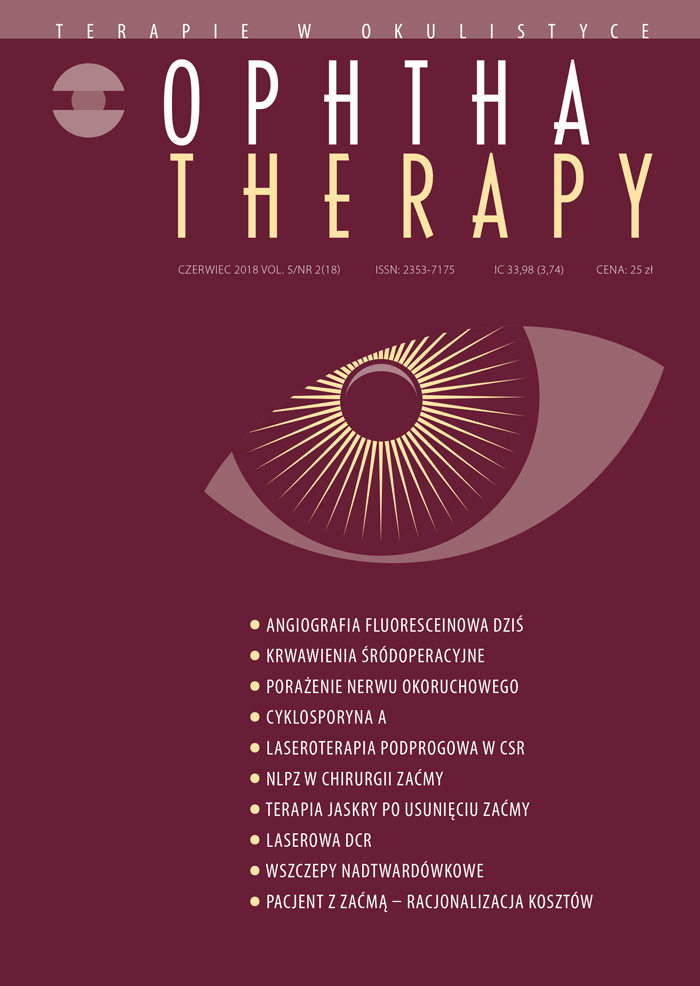Use of topical non-steroidal anti-inflammatory drugs as part of perioperative cataract surgery care
Main Article Content
Abstract
Cataract is the leading cause of blindness in the world, but it is reversible in almost 100% of cases. Activation of the immune system and the intensive production of the prostaglandins following the cataract surgery may induce clinical symptoms including redness, miosis, decreased visual acuity, eye pain and cystoid macular edema (CME). CME is the main cause of reduced visual acuity after an uncomplicated cataract surgery. In order to reduce ailments, increase comfort and prevent complications, patients receive local anti-inflammatory drugs after the phacoemulsification procedure. Topical non-steroidal anti-inflammatory drugs (NSAIDs) are especially dedicated to older diabetic patients and also to people who experienced some complications during the cataract surgery or in whom high ultrasound energy was released during phacoemulsification. As an element of the CME prevention, it is worth to consider the use of the topical NSAIDs in patients with concomitant eye diseases such as epiretinal membrane, uveitis, central retinal vein occlusion and after retinal detachment.
Downloads
Article Details

This work is licensed under a Creative Commons Attribution-NonCommercial-NoDerivatives 4.0 International License.
Copyright: © Medical Education sp. z o.o. License allowing third parties to copy and redistribute the material in any medium or format and to remix, transform, and build upon the material, provided the original work is properly cited and states its license.
Address reprint requests to: Medical Education, Marcin Kuźma (marcin.kuzma@mededu.pl)
References
2. Bourne R, Price H, Stevens G, and the GBD Vision Loss Expert Group. Global Burden of Visual Impairment and Blindness. Arch Ophthalmol. 2012; 130(5): 645-7.
3. Gomez ML. Measuring the quality of vision after cataract surgery. Curr Opin Ophthalmol. 2014; 25(1): 3-11.
4. Tseng VL, Yu F, Lum F et al. Risk of Fractures Following Cataract Surgery in Medicare Beneficiaries. JAMA. 2012; 308(5): 493-501.
5. Brian G, Taylor H. Cataract blindness – challenges for the 21st century. Bull World Health Organ. 2001; 79(3): 249-56.
6. Colin J. The Role of NSAIDs in the Management of Postoperative Ophthalmic Inflammation. Drugs. 2007; 67(9): 1291-308.
7. Ahuja M, Dhake AS, Sharma SK. Topical ocular delivery of NSAIDs. AAPS J. 2008; 10(2): 229-41.
8. Kohnen T. Treating inflammation after lens surgery. J Cataract Refract Surg. 2015; 41(10): 2035.
9. Agange N, Mosaed S. Prostaglandin-Induced Cystoid Macular Edema Following Routine Cataract Extraction. J Ophthalmol. 2010; 2010: 1-3.
10. Anelli MG, Scioscia C, Grattagliano I. Old and New Antirheumatic Drugs and the Risk of Hepatotoxicity. Ther Drug Monit. 2012; 34(6): 622-8.
11. Jessurun N, van Puijenbroek E. Relationship Between Structural Alerts in NSAIDs and Idiosyncratic Hepatotoxicity: An Analysis of Spontaneous Report Data from the WHO Database. Drug Saf. 2015; 38(5): 511-5.
12. Macario A, Lipman AG. Ketorolac in the Era of Cyclo-Oxygenase-2 Selective Nonsteroidal Anti-Inflammatory Drugs: A Systematic Review of Efficacy, Side Effects, and Regulatory Issues. Pain Med. 2001; 2(4): 336-51.
13. Flach AJ. Corneal melts associated with topically applied nonsteroidal anti-inflammatory drugs. Trans Am Ophthalmol Soc. 2001; 9999: 205-12.
14. Gabison EE, Chastang P, Menashi S. Late corneal perforation after photorefractive keratectomy associated with topical diclofenac: involvement of matrix metalloproteinases. Ophthalmology. 2003; 110(8): 1626-31.
15. Asai T, Nakagami T, Mochizuki M et al. Three cases of corneal melting after instillation of a new nonsteroidal anti-inflammatory drug. Cornea. 2006; 25(2): 224-7.
16. Congdon NG, Schein OD, von Kulajta P et al. Corneal complications associated with topical ophthalmic use of nonsteroidal antiinflammatory drugs. J Cataract Refract Surg. 2001; 27(4): 622-31.
17. Wolf EJ, Kleiman LZ, Schrier A. Nepafenac-associated corneal melt. J Cataract Refract Surg. 2007; 33(11): 1974 -5.
18. Jurowski P, Kęcik D, Omulecki W et al. Wytyczne Polskiego Towarzystwa Okulistycznego: Postępowanie okołooperacyjne w chirurgii zaćmy. PTO, 2014.
19. Bakunowicz-Łazarczyk A, Gosławski W, Grabska-Liberek I et al. Wstęp; Pacjenci chorzy na cukrzycę jako grupa podwyższonego ryzyka wystąpienia CME po operacji zaćmy. In: Stanowisko Grupy Eksperckiej na temat stosowania nepafenaku w profilaktyce pooperacyjnego obrzęku plamki żółtej po chirurgicznym leczeniu zaćmy u pacjentów chorych na cukrzycę. PTO, 2011.
20. Kim SJ, Schoenberger SD, Thorne JE et al. Topical Nonsteroidal Anti-inflammatory Drugs and Cataract Surgery. Ophthalmology. 2015; 122(11): 2159-68.
21. Quinn CJ. Cystoid macular edema. Optom Clin. 1996; 5(1): 111-30.
22. O’Brien TP. Emerging guidelines for use of NSAID therapy to optimize cataract surgery patient care. Curr Med Res Opin. 2005; 21(7): 1131-7.
23. Ray S, D’Amico DJ. Pseudophakic cystoid macular edema. Semin Ophthalmol. 2002; 17(3-4): 167-80.
24. Ursell PG, Spalton DJ, Whitcup SM et al. Cystoid macular edema after phacoemulsification: relationship to blood-aqueous barrier damage and visual acuity. J Cataract Refract Surg. 1999; 25(11): 1492-7.
25. Yonekawa Y, Kim IK. Pseudophakic cystoid macular edema. Curr Opin Ophthalmol. 2012; 23(1): 26-32.
26. Anastasilakis K, Mourgela A, Symeonidis C et al. Macular Edema after Uncomplicated Cataract Surgery: A Role for Phacoemulsification Energy and Vitreoretinal Interface Status? Eur J Ophthalmol. 2015; 25(3): 192-7.
27. Lin CJ, Tsai YY. Use of Aflibercept for the Management of Refractory Pseudophakic Macular Edema in Irvine gass Syndrome and Literature Review. Retin Cases Brief Rep. 2018; 12(1): 59-62.
28. Irvine SR. A newly defined vitreous syndrome following cataract surgery. Am J Ophthalmol. 1953; 36(5): 599-619.
29. Chu CJ, Johnston RL, Buscombe C et al. Risk Factors and Incidence of Macular Edema after Cataract Surgery. Ophthalmology. 2016; 123(2): 316-23.
30. Wolf EJ, Braunstein A, Shih C et al. Incidence of visually significant pseudophakic macular edema after uneventful phacoemulsification in patients treated with nepafenac. J Cataract Refract Surg. 2007; 33(9): 1546-9.
31. Malik A, Sadafale A, Gupta Y et al. A comparative study of various topical nonsteroidal anti-inflammatory drugs to steroid drops for control of post cataract surgery inflammation. Oman J Ophthalmol. 2016; 9(3): 150-6.

